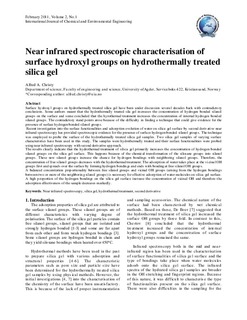| dc.contributor.author | Christy, Alfred A. | |
| dc.date.accessioned | 2011-09-07T12:38:28Z | |
| dc.date.available | 2011-09-07T12:38:28Z | |
| dc.date.issued | 2011 | |
| dc.identifier.citation | Christy, A. A. (2011). Near infrared spectroscopic characterisation of surface hydroxyl groups on hydrothermally treated silica gel. International Journal of Chemical and Environmental Engeineering, 2(1), 27-32. | en_US |
| dc.identifier.issn | 2078-0737 | |
| dc.identifier.uri | http://hdl.handle.net/11250/138258 | |
| dc.description | Published version of an article in the journal International Journal of Chemical and Environmental Engeineering, 2 (1), 27-32. Also available at: http://www.warponline.org/4.%20Near%20infrared%20spectroscopic%20characterisation%20of%20surface%20hydroxyl%20groups%20on%20hydrothermally%20treated%20silica%20gel.pdf OA | en_US |
| dc.description.abstract | Surface hydroxyl groups on hydrothermally treated silica gel have been under discussion several decades back with contradictory conclusions. Some authors meant that the hydrothermally treated sila gel increases the concentration of hydrogen bonded silanol groups on the surface and some concluded that the hyrothermal treatment increases the concentration of internal hydrogen bonded silanol groups. The contradictory stand points arose because of the difficulty in finding a technique that could give evidence for the presence of surface hydrogen bonded silanol groups.Recent investigation into the surface functionalities and adsorption evolution of water on silica gel surface by second derivative near infrared spectroscopy has provided spectroscopic evidence for the presence of surface hydrogen bonded silanol groups. The technique was employed to probe the surface of the hydrothermally treated silica gel samples. Two silica gel samples of varying surface characteristics have been used in this study. The samples were hydrothermally treated and their surface functionalities were probed using near infrared spectroscopy with second derivative approach.The results clearly indicate that the hydrothermal treatment of silica gel primarily increases the concentration of hydrogen bonded silanol groups on the silica gel surface. This happens because of the chemical transformation of the siloxane groups into silanol groups. These new silanol groups increase the chance for hydrogen bondings with neighboring silanol groups. Therefore, the concentration of free silanol groups decreases with the hydrothermal treatment. The adsorption of water takes place at the vicinal OH groups first and spreads over the surface by forming hydrogen bondings and ends with bonding at free silanol OH groups.A balanced concentration proportionality between free silanol groups and vicinal OH groups (arising from the hydrogen bondings between two or more of the neighboring silanol groups) is necessary for effective adsorption of water molecules on silica gel surface. A high proportion of the hydrogen bondings on the silica gel surface increase the concentration of vicinal OH and therefore the adsorption effectiveness of the sample decreases markedly. | en_US |
| dc.language.iso | eng | en_US |
| dc.publisher | DOAJ | en_US |
| dc.title | Near infrared spectroscopic characterisation of surface hydroxyl groups on hydrothermally treated silica gel | en_US |
| dc.type | Journal article | en_US |
| dc.type | Peer reviewed | en_US |
| dc.subject.nsi | VDP::Mathematics and natural science: 400::Chemistry: 440 | en_US |
| dc.source.pagenumber | 27-32 | en_US |
| dc.source.volume | 2 | |
| dc.source.journal | International Journal of Chemical and Environmental Engineering | |
| dc.source.issue | 1 | |
